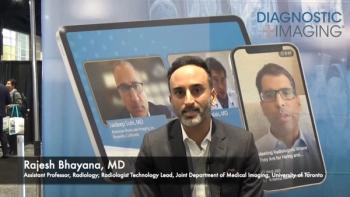
- Diagnostic Imaging Vol 32 No 10
- Volume 32
- Issue 10
LifeImage takes sting out of viewing patient CDs
Sharing x-ray jackets is dead. PACS put an end to that. Now patients walk in with CDs. And it's causing a whole new kind of headache.
Sharing x-ray jackets is dead. PACS put an end to that. Now patients walk in with CDs. And it's causing a whole new kind of headache.
“This is not Walgreens (drug store),” said Michael Favreau, director of imaging and special projects at Baystate Health in Springfield, MA.
And the images on the discs are not weekend snapshots of the family picnic. They may be 2000- or 3000-slice CT studies, created in different formats. They may all be DICOM-compatible, but not all of them are readable by Baystate Health.
“The CDs come from different PACS and the viewers are not uniform,” Favreau said. “So there are different challenges opening them and looking at the full set of images.”
Baystate Health turned to LifeImage in January of this year to solve the problem for its 683-bed Springfield medical center, as well as its several other facilities in Massachusetts. The Newton, MA, information technology start-up offers a portfolio of products and services designed to take the edge off image sharing by harnessing cloud computing to transfer images from place to place electronically.
But Baystate is staying out of the cloud, choosing disc viewers instead of electronic transfer. They simply wanted to solve the logjam of CDs that kept piling up, especially at its Springfield center, which includes a tertiary-care referral medical center, a Level 1 trauma center, and neonatal and pediatric intensive care units.
Those viewers are part of LILA, the LifeImage Local Appliance, which is installed on Baystate's private network. LILA includes inboxes for authorized users to hold data files obtained from patient CDs and the tools needed to view, store, and share these files. Along with medical images, they may include doctors' notes, reports, EKGs-anything that can be stored digitally.
Since Baystate began using the technology 11 months ago, LILA has successfully read and managed the contents of at least 95% of the CDs coming into Baystate facilities, according to Favreau.
Baystate is one of the first, but it is not the only health system to use LILA. About two dozen hospitals are using this technology along with other services from LifeImage. Among them are Memorial Sloan-Kettering Cancer Center in New York and Boston's Massachusetts General Hospital, where Dr. Keith Dreyer and colleagues did much of the developmental work.
LifeImage is now commercializing and evolving the technology, which company president and CEO Hamid Tabatabaie likens to a long-distance telephone service.
Eventually Baystate may take advantage of that long-distance service, but for now it is using only the most basic services. LILA manages CDs accompanying trauma and pediatric patients, Favreau said, selectively uploading images and data to Baystate's electronic health record system. The near-term plan is to add inboxes for specialties such as neurology, cardiology, and vascular.
In the long term, Baystate may enhance its viewers with Internet connections that transfer images from one site to Baystate and Baystate to elsewhere using cloud computing. But Favreau and his staff are taking baby steps for now and are satisfied with the results.
“We have had only minor problems,” he said. “And every problem we have had, when we called LifeImage, it was corrected immediately.”
Articles in this issue
about 15 years ago
Coronary CTA really works, but why isn't its use soaring?about 15 years ago
Case of the Monthabout 15 years ago
Small pulmonary emboli still stump radiologistsabout 15 years ago
Leukemia joins radiation risks for interventionalistsabout 15 years ago
MRI reveals when cognitive impairment will advanceabout 15 years ago
Imaging technique proves useful for ovarian cancerabout 15 years ago
Incidental findings can predict cardiac diseaseabout 15 years ago
Delayed cardiac test saves moneyabout 15 years ago
The deck is stacked against coronary CTA; why it mattersabout 15 years ago
We spend on end-of-life care at expense of patientsNewsletter
Stay at the forefront of radiology with the Diagnostic Imaging newsletter, delivering the latest news, clinical insights, and imaging advancements for today’s radiologists.




























